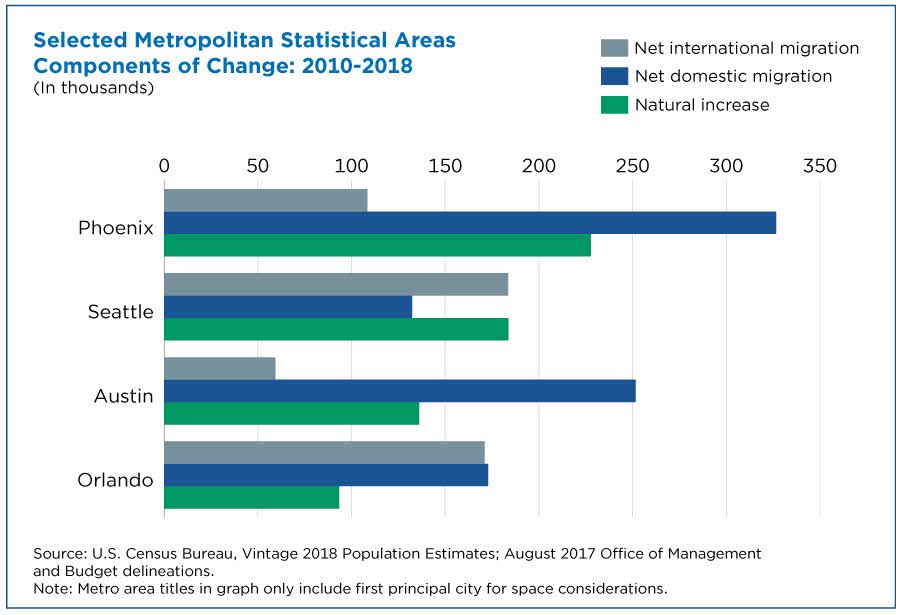Dallas and Houston Are Now Fourth and Fifth Most Populous in the Nation
Two of the top three largest gaining metropolitan statistical areas from 2010 to 2018 were in the state of Texas.
The Dallas-Fort Worth-Arlington and Houston-The Woodlands-Sugar Land metro areas each gained over 1,000,000 people, according to July 1, 2018, population estimates released today. With estimated populations of 7,539,711 and 6,997,384, respectively, Dallas and Houston are positioned as the fourth and fifth most populous metro areas in 2018.
Typically, metropolitan areas that add the most people are also among the most populous ... Yet, some metro areas that gained a lot of people are not among the most populous.
The Office of Management and Budget delineates a metro area as one or more counties associated with at least one urban core of at least 50,000 people. It includes adjacent counties that have commuting ties to the urban center.
Typically, metropolitan areas that add the most people are also among the most populous. This is due to a higher potential for change that can alter the population, such as births, deaths and migration — both domestic and international.
Yet, some metro areas that gained a lot of people are not among the most populous.
Phoenix-Mesa-Scottsdale, Ariz.; Seattle-Tacoma-Bellevue, Wash.; Austin-Round Rock, Texas; and Orlando-Kissimmee-Sanford, Fla., were among the 10 largest metros by numeric growth, but not among the 10 most populous in 2018, ranking third, seventh, ninth and tenth, respectively.
What Affects Population Growth
Phoenix, with an estimated gain of 664,835 people since 2010, ranks third in cumulative numeric growth and is poised to become one of the most populous metropolitan areas.
Growth in the Phoenix metro area can primarily be attributed to a net gain of people moving from other parts of the United States (domestic migration) and from births outnumbering deaths (natural increase).
Although the Seattle metro gained fewer people than Phoenix (499,558), it still ranks seventh in cumulative numeric growth. Seattle’s population grew 14.5 percent since 2010 and, like Phoenix, is growing in part due to natural increase.
Seattle is also gaining in population as a result of people moving to the area from places outside of the United States (net international migration).
Some Metro Areas Are Top Gainers and Fastest Growing
Austin and Orlando have become two of the fastest-growing metropolitan areas by both percent and numeric change.
Austin’s metro area population increased by 26.3 percent (451,995 people) since 2010 and was the third fastest-growing metro and ranks ninth in cumulative numeric growth. The growth is largely attributed to increases in net domestic migration.
Orlando’s population of 2,572,962 grew 20.5 percent (438,560 people), positioning the area as the ninth fastest-growing metro and tenth largest-gaining metro between 2010 and 2018.
Net domestic and international migration are the main demographic components contributing to Orlando’s growth.
To learn more about the other growing metropolitan areas, view the most recent population estimates release.
Subscribe
Our email newsletter is sent out on the day we publish a story. Get an alert directly in your inbox to read, share and blog about our newest stories.
Contact our Public Information Office for media inquiries or interviews.
-
PopulationFast Growth in the Desert Southwest ContinuesFebruary 11, 2019One of the most arid parts of the country has enjoyed population growth of more than 40 percent in three different decades since 1950.
-
PopulationRural and Lower-Income Counties Lag Nation in Internet SubscriptionDecember 06, 2018Nationally, 78 percent of households subscribe to the internet but households in both rural and lower-income counties lag behind.
-
PopulationA Snapshot of the Fast-Growing U.S. Older PopulationOctober 30, 2018The growth of the U.S. population age 65 and older exceeds that of the total population and the population under age 65.
-
PopulationTribal Casinos: An Economic BoonNovember 20, 2025A new study explores how tribal casino expansion in the 1990s and 2000s affected poverty, jobs and income for American Indian communities and their neighbors.
-
NAICS Sector 31-33 ManufacturingSome Less Populous States Have High Manufacturing Revenue Per CapitaSeptember 29, 2025Today is the start of a week of celebrations at the Census Bureau marking the 14th annual Manufacturing Day on October 3.
-
Families and Living ArrangementsCouples’ Finances: Married but SeparateSeptember 24, 2025While most married couples had joint bank accounts, fewer shared all their financial accounts.
-
FertilityChildlessness on the Rise — Except for Women Ages 45 to 50September 23, 2025From 2014 to 2024, the share of older mothers rose as fewer teens and women in their 20s and 30s had children.





